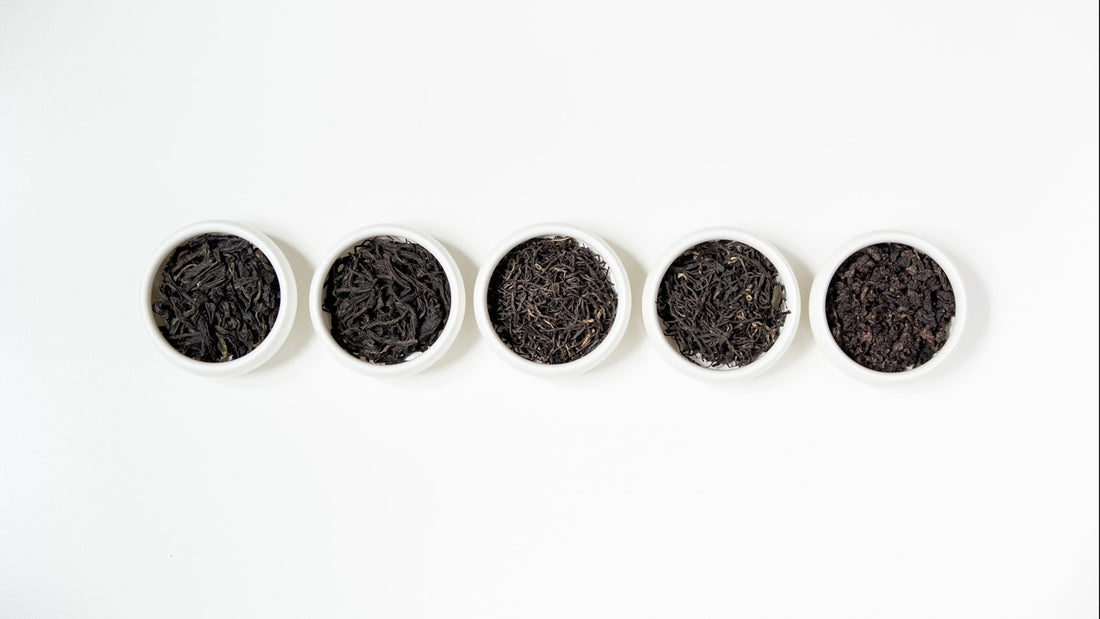The teas from our Vol. 5 Exploration Kit are perfect for sipping on chilly days. In the kit, you'll find three different black teas and two oolong teas from Eastern China. From hand roasted oolong to the mother of all black teas, this exploration will surely leave you warm and cozy. Check out our tea stories below to learn more about what's in your cup.
Keemun
Red Plum Black
Zhengshan Xiaozhong (unsmoked)
Charcoal Roasted Tie Guan Yin
Rou Gui
Here's a map to give you an idea of the journey this Exploration Kit will take you. Locations are approximate and intended to serve as a visual guide only.
Keemun

祁門紅茶
Black Tea
Spring 2021
Huangshan, Anhui, China
This relatively young tea from the 19th century managed to captivated the royalties in the West with its malty and floral notes. Nowadays, you can find Keemun on its own or in many wonderful tea blends gracing the shelves of supermarkets as well as the menu of fine dining restaurants.
Notes: Floral, Malty
Gongfu:
4g | 100ml | 95c | 20 secs
Western:
2.5g | 250ml | 90c | 2-3 mins
Grown on the majestic Huangshan, this Keemun black tea was harvested and processed just this past spring. Classified as Qi Hong Mao Feng (祁門毛峰), it was processed with a newer and different bruising technique to further enhance the quality of the tea.
The story of Keemun
Arguably one the most famous Chinese black teas, as well as the only black tea in the top 10 Chinese tea, Keemun first appeared in Qimen around 1875. Prior to that only green tea was the only tea production in this region. Records showed that a government official, Yu Gan Chen (餘干臣), was inspired by black tea production in Fujian and decided to bring this tea processing technique back to his home town. As it turned out, the tea plants in Qimen were most suitable for yielding high quality black tea and it quickly gained popularity in the West. Exporting from Amoy, Qimen black tea was officially named Keemun in English based on the Cantonese pronunciation. And the rest is history.
Red Plum Black

Black Tea
Spring 2021
Hangzhou, Zhejiang, China
When people think about tea from Hangzhou, Dragonwell would immediately come to mind 99% of the time. It’s unfortunate that not many people know about the award-winning Red Plum Black, which is the only specialty black tea produced within the Zhejiang tea region.
Notes: Fruity, Floral
Gongfu:
4g | 100ml | 95c | 45 secs
Western:
2.5g | 250ml | 90c | 2-3 mins
This Red Plum Black was harvested around Guyi (谷雨) this Spring. With one bud and two leaves, this black tea brews up an elegant golden red liquor with a delicate and soothing floral flavor.
The story of Red Plum Black
Red Plum Black is another story about skill transfer. Zhejiang has always been known for its famous green tea production. Yet less than 200 years ago, during the Taiping Heavenly Kingdom period in the Qing Dynasty, tea farmers from Wuyishan Fujian migrated to Hangzhou. Armed with black tea processing technique, they applied it to the same cultivar of tea for Dragonwell and successfully developed Red Plum Black. The tea was named after Jiu Qu River (九曲溪), to pay tribute to one of the landmarks from their hometown.
Red Plum Black has since charmed many tea lovers, including Master Hongyi (弘一法師) who has dedicated a poem for it:
白玉杯中瑪瑙色,紅唇舌底梅花香
Agate red liquor in the white jade porcelain cup
Plum blossom aroma under the red lips and tongue
Even though Red Plum Black has won awards such as gold medal in 1928 Shanghai Expo, it seems to be always outshone by Dragonwell. In any case, we are happy to be able to taste this gentle black tea that shares the same tea cultivar as Dragonwell but yields such different taste and aroma.
Zhengshan Xiaozhong (Unsmoked)

正山小種
Black Tea
Spring 2021
Wuyishan, Fujian, China
Zhengshan Xiaozhong aka Lapsang Soucong, is the origins of all black tea. Traditionally, its smokey characteristic is the most controversial note that people would either love it or hate it with little middle ground. Some people fell for the smokey longan flavor while others think it tastes nothing but a campfire. So for our kit, we have selected an unsmoked version to tap into this tea with ease.
Notes: Floral, Woody
Gongfu:
5g | 100ml | 90c | 30 secs
Western:
3g | 250ml | 90c | 2-3 mins
Our Zhengshan Xiaozhong is harvested and processed in Tongmu Village this spring by the fourth-generation tea farmer and processor. Tongmuguan is part of the Wuyi Natural Reserve and it’s restricted from outsiders. This protection further ensures the pristine environment remains as undisturbed as possible.
The story of Zhengshan Xiaozhong
Being the mother of all black tea, Zhenshan Xiaozhong started as a beautiful accident in the Ming Dynasty around the 16th century. During the tea harvesting season, military troops arrived at Tongmuguan unannounced and took over a little tea farm to setup camp. Soldiers were resting and lying on the freshly harvested tea leaves. When they finally left, the tea farmers were shocked to find the fully oxidized tea had turned all red. In try to salvage them, he decided to dry them quickly with pinewood that they’d normally used for cooking. Little did he know he has formulated the world’s first black tea.
The tea has gained popularity by merchants from the West and people came back for more year after year. It was named officially as Lapsang Souchong in English by the European traders, based on its Fuzhou dialect pronunciation.
Nowadays, with the advancement in tea processing technique and market trend, many zhengshan Xiaozhong tea processors opted to produce the unsmoked version of the tea, making it easier to enjoy. But we still urge you to seek out the smoked version if you haven’t tried.
Charcoal Roasted Tie Guan Yin


炭焙鐵觀音
Oolong Tea
Spring 2021
Anxi, Fujian, China
Tie Guan Yin, aka Iron Goddess of Mercy or Iron Buddha, is a tea that has won many hearts with its unique floral quality. While jade / light version of it seems to be trending in recent years, we were really excited when we came across this charcoal roasted Tie Guan Yin that gives off a more traditional vibe.
Notes: Nutty, Fruity
Gongfu:
5g | 100ml | 98c | 45 secs
Western:
4g | 250ml | 98c | 2 mins 30 secs
This charcoal roasted Tie Guan Yin came from Gande (感德), a town with hilly terrain and high elevation, perfect for tea cultivation. Naturally, it became one of the main regions in Anxi with a long history of Tie Guan Yin production. Apart from the meticulous oolong processing, the tea has also been through multiple rounds of charcoal roasting by hand. This step adds a richer layer of flavor and aroma, making it a great tea to enjoy, especially when the temperature drops.
The story of Charcoal Roasted Tie Guan Yin
While many love charcoal roasted Tie Guan Yin for its added complexity and coziness, its invention came as a practical necessity. In the old days, many Fujian people traveled by sea, and tea was one of the staple they brought along. Since partially oxidized oolong couldn’t withstand the humidity at sea, people then discovered that they could combat this problem by charcoal roasting it. Not only can the tea be kept in better conditions this way, its flavor were also enhanced as a bonus.
Nowadays, with the change in preferences, not all Tie Guan Yin producers would opt to go through the time and labour intensive charcoal roasting by hand. It also takes people years of practice and experience to master this skill, so it’s incredibly lucky whenever we chance upon a tea produced in this traditional manner.
Rou Gui

肉桂
Oolong Tea
Spring 2021
Wuyishan, Fujian, China
It’s no secret that oolong tea is one of our favorite tea type. Within the oolong family, cliff tea is near the top of our chart. That is why we are excited, after Qilan from Vol 3, to include another cliff tea for your tea exploration.
Notes: Mineral, Floral
Gongfu:
4g | 100ml | 98c | 10-15 secs
Western:
3g | 250ml | 98c | 2-3 mins
This medium roasted Rou Gui was harvested this spring. Being named Rou Gui, which is cinnamon in Chinese, a hint of this spice can certainly be found, especially from the dry leaves on the nose. Yet we are often distracted by the fruity and sweet aroma once it’s brewed.
The story of Rou Gui
Originated from Hui Yuan Keng (慧苑坑), Rou Gui is an indigenous varietal in Wuyishan. By the 60’s, due to its consistent high quality, it became one of the top 10 varietals planted around Wuyishan, more so in present days. It was dubbed to be the first three must-have Wuyi cliff teas (the other two are Big Red Robe and Shui Xian).
When you dive deeper into the world of cliff tea, you might start to hear people speaking fondly about “horse meat” and “Beef”, and very often with a dreamy look on their faces. Don’t be alarmed because they are only acronyms of Rou Gui (Meat/Rou/肉) from different areas within Wuyishan. Horse Meat (馬肉) refers to Rou Gui from Ma Tou Yan (馬頭岩), while Beef (牛肉) means Rou Gui from Niu Lan Keng (牛欄坑). These are some of the most prized areas within Central Wuyishan where the microclimate and conditions yield the most flavorful cliff tea that lingers in your mouth.

